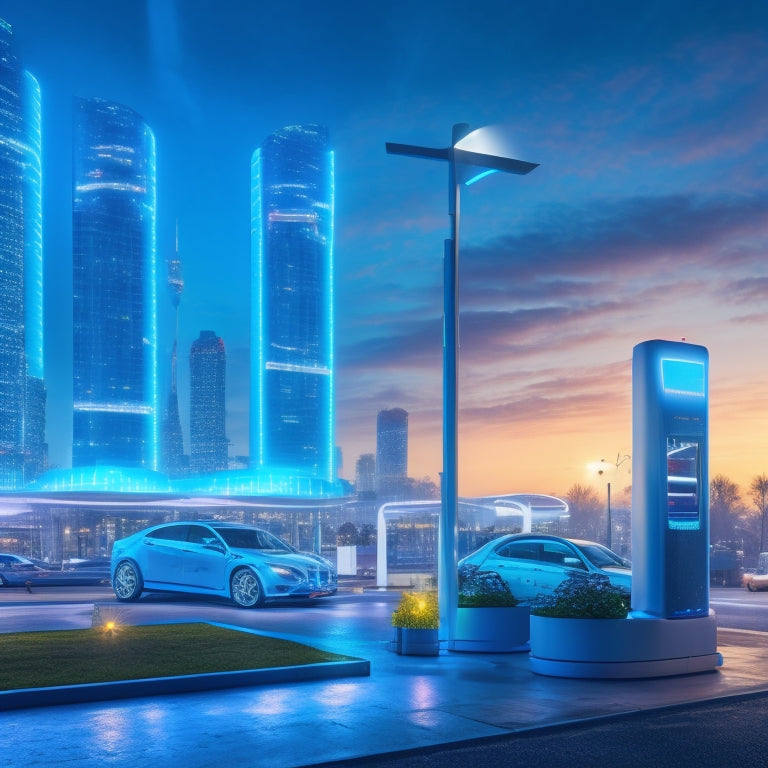
Why High-Efficiency Inverters Matter for EV Charging Hubs
Share
You need high-efficiency inverters in EV charging hubs to maximize energy harvesting, reduce energy losses and heat generation, and guarantee a stable power supply. They're essential for minimizing grid impact, reducing operating costs, and carbon footprint. With high-efficiency inverters, you can enjoy faster charging times, higher power density, and enhanced user experience. They also provide a reliable and clean power supply, minimizing downtime and equipment failure risks. By leveraging high-efficiency inverters, you'll be able to optimize power distribution, reduce congestion, and future-proof your EV charging infrastructure – and that's just the beginning of the benefits you'll discover.
Key Takeaways
• High-efficiency inverters optimize energy harvesting, reducing dependence on the grid and minimizing energy losses for stable EV charging hub operations.
• They ensure peak performance, reduce operating costs, and carbon footprint, while preventing overheating and equipment lifespan extension.
• Inverters with fine-tuned MPPT algorithms maximize power extraction, enhancing grid resiliency and reducing downtime risks for reliable and clean power supply.
• They enable faster refueling times, higher power density, and reduced congestion in charging queues, enhancing the overall user experience.
• By regulating power flow, high-efficiency inverters mitigate peak demand, preventing brownouts or blackouts, and increasing grid resilience for future-proof EV charging infrastructure.
Unlocking Maximum Energy Harvesting
To optimize the energy yield from solar panels or wind turbines, you need to fine-tune the inverter's maximum power point tracking (MPPT) algorithm, which ensures that the inverter extracts the maximum available power from the renewable energy source.
By doing so, you'll unleash the full potential of your energy harvesting system. This is crucial for EV charging hubs, where energy storage is essential for maintaining a stable and reliable power supply.
A high-efficiency inverter with advanced MPPT capabilities empowers you to harness more energy, reducing your dependency on the grid and enhancing grid resiliency.
Reducing Energy Loss and Heat
By incorporating high-efficiency inverters with advanced thermal management systems, you can minimize energy losses and reduce heat generation, guaranteeing that your EV charging hub operates at peak performance.
This is essential because energy wastage can lead to reduced efficiency, increased operating costs, and even safety risks. With high-efficiency inverters, you can decrease energy losses by up to 50%, resulting in significant cost savings and a reduced carbon footprint.
Advanced thermal management systems also help to dissipate heat more effectively, preventing overheating and extending the lifespan of your equipment. By reducing energy wastage and heat generation, you can ensure reliable, efficient, and safe EV charging operations.
Increased Charging Speed and Capacity
By integrating high-efficiency inverters into your EV charging hub, you can greatly enhance the charging speed and capacity, enabling quicker refueling times and supporting a larger volume of simultaneous charging sessions. This means reduced wait times in the charging queue, resulting in a better overall user experience.
Here are three key benefits of increased charging speed and capacity:
-
Faster Refueling: High-efficiency inverters enable faster charging speeds, reducing the time spent waiting for a full charge.
-
Increased Power Density: By supporting a higher power output, you can accommodate more charging stations in a smaller area, maximizing your hub's power density.
-
Reduced Congestion: With faster charging and higher capacity, you can reduce congestion in the charging queue, minimizing frustration for EV owners and maximizing the efficiency of your hub.
Reliable and Consistent Power Supply
High-efficiency inverters in your EV charging hub guarantee a reliable and consistent power supply, enabling you to maintain a steady flow of electricity to your charging stations and minimize downtime.
This consistency is crucial, as it directly impacts the overall power quality and grid resilience of your charging infrastructure. With high-efficiency inverters, you can secure that your charging stations receive a stable and clean power supply, reducing the risk of equipment failure and downtime.
This, in turn, allows you to uphold a high level of grid resilience, ensuring that your charging hub can operate efficiently even during periods of high demand or grid instability.
Minimizing Grid Impact and Strain
Your high-efficiency inverters can greatly reduce the strain on the grid by regulating the flow of power and mitigating peak demand, ensuring a smoother and more efficient charging experience. By doing so, you can minimize the impact on the grid and reduce the risk of brownouts or blackouts.
Here are three ways high-efficiency inverters help:
-
Grid Resilience: By regulating power flow, high-efficiency inverters reduce stress on the grid, increasing its overall resilience.
-
Peak Shaving: By mitigating peak demand, high-efficiency inverters reduce the strain on the grid during peak usage hours, preventing brownouts or blackouts.
-
Reduced Grid Congestion: By optimizing power distribution, high-efficiency inverters reduce congestion on the grid, ensuring a smoother and more efficient charging experience.
Cost Savings Through Efficiency
By optimizing your EV charging hub with high-efficiency inverters, you can anticipate significant cost savings through reduced energy losses and lower operational expenditures. By minimizing energy waste, you'll observe a direct impact on your bottom line.
Peak hours optimization guarantees that your charging hub operates at maximum efficiency during periods of high demand.
Energy consumption profiling provides valuable insights into your energy usage patterns, allowing you to identify areas for improvement.
With high-efficiency inverters, you can decrease your energy consumption during off-peak hours, further minimizing your operational costs.
Enhanced Safety Features and Monitoring
Incorporating advanced safety features and real-time monitoring capabilities into your EV charging hub's high-efficiency inverters guarantees that your operation runs smoothly and safely, even in high-stress environments. You'll have complete control over your charging hub, ensuring maximum uptime and minimizing downtime.
Here are three key benefits:
-
Real-time alerts: Receive instant notifications of potential issues, allowing you to take proactive measures to prevent downtime.
-
Cybersecurity protocols: Protect your system from cyber threats with built-in security features, keeping your data and operations secure.
-
Advanced monitoring: Get real-time insights into your charging hub's performance, enabling data-driven decisions to optimize your operation.
Simplified Installation and Maintenance
When you're setting up an EV charging hub, you want to get it up and running quickly and smoothly. That's why you'll appreciate the simplified installation process of high-efficiency inverters, which reduces the risk of downtime and gets your hub operational faster.
Easy Installation Process
You can significantly reduce the time and effort required to set up an EV charging hub by selecting high-efficiency inverters that feature a simplified installation process. This streamlined approach guarantees a quicker turnaround, getting your charging station up and running faster.
With toolless setup, you can eliminate the need for tedious wiring and complex configurations. In addition, high-efficiency inverters often come equipped with:
-
Wireless connectivity, enabling seamless communication between devices and remote monitoring capabilities.
-
Modular design, allowing for easy replacement of components and reduced maintenance downtime.
-
Intuitive interfaces, providing a user-friendly experience for operators and reducing the learning curve.
Reduced Downtime Risks
By opting for high-efficiency inverters with simplified installation and maintenance, you can significantly reduce downtime risks, guaranteeing that your EV charging hub remains operational and profitable.
With real-time monitoring capabilities, you'll receive instant notifications of potential issues, allowing you to take proactive measures to prevent downtime. Predictive analytics also enable you to identify potential faults before they occur, further decreasing the likelihood of unplanned outages.
By leveraging these advanced features, you can maintain continuous operation and maximize revenue generation.
With high-efficiency inverters, you'll be better equipped to manage your EV charging hub with confidence, knowing that you've taken every precaution to minimize downtime risks and maintain a seamless user experience.
Streamlined Maintenance Needs
High-efficiency inverters also simplify installation and maintenance procedures, eliminating the need for extensive technical expertise and reducing the time spent on routine upkeep. This means you can focus on more pressing matters, like ensuring your EV charging hub is running at peak performance.
With high-efficiency inverters, you'll experience:
-
Fewer Scheduled Downtimes: Predictive analytics and remote monitoring enable you to identify potential issues before they become major problems, reducing the need for unplanned downtime.
-
Simplified Troubleshooting: Intuitive interfaces and diagnostic tools make it easy to identify and resolve issues quickly, minimizing maintenance time and effort.
-
Extended Equipment Lifespan: Regular software updates and real-time monitoring help prevent equipment failures, extending the lifespan of your inverters and reducing the need for frequent replacements.
Future-Proofing EV Charging Infrastructure
As the global electric vehicle (EV) fleet continues to grow, it's crucial that charging infrastructure keeps pace, with future-proofing measures guaranteeing seamless integration of emerging technologies and increasing power demands.
You need to prioritize scalable design in your EV charging infrastructure to accommodate future upgrades and expansions. This means incorporating adaptive technology that can evolve with the rapidly changing EV landscape. By doing so, you'll secure that your charging hub remains compatible with emerging standards and can handle increasing power demands.
This proactive approach will save you from costly retrofits and downtime, allowing you to maintain a competitive edge in the EV charging market.
Frequently Asked Questions
Can High-Efficiency Inverters Be Used for Both AC and DC Fast Charging?
You can utilize high-efficiency inverters for both AC and DC fast charging, as they efficiently convert power between different charging modes, ensuring seamless power conversion and peak performance in various EV charging applications.
How Do Inverters Affect the Overall Cost of EV Charging Infrastructure?
You'll be surprised to learn that 40% of EV charging infrastructure costs are attributed to electrical infrastructure. By leveraging high-efficiency inverters, you can access significant cost savings through infrastructure optimization, reducing overall costs by up to 15%.
Are High-Efficiency Inverters Compatible With Existing Charging Station Hardware?
You'll find that high-efficiency inverters are generally compatible with existing charging station hardware, but it's important to verify inverter compatibility with specific hardware configurations to guarantee seamless integration and peak performance.
Do High-Efficiency Inverters Require Specialized Installation or Training?
You'll need certified technicians with specialized training to install high-efficiency inverters, which may require additional certification programs. Onsite support is also vital to guarantee proper installation and minimize downtime.
Can High-Efficiency Inverters Be Integrated With Renewable Energy Sources?
You think you're done with the inverter puzzle, but what about harnessing renewable energy sources? Relax, high-efficiency inverters can seamlessly integrate with energy harvesting systems, achieving grid parity, and giving you total control over your energy destiny.
Related Posts
-

3 Ways Wind Power Boosts Home Value
Living near a wind farm can enhance your property's value in three significant ways. To begin with, proximity to wind...
-

Why Choose Solar Composting Toilets for Your Home?
By choosing a solar composting toilet for your home, you'll greatly reduce your environmental impact, slashing your w...
-

10 Eco-Friendly Air Management Tools for Clean Home Living
You're taking an essential step towards creating a healthier living space by seeking eco-friendly air management tool...


